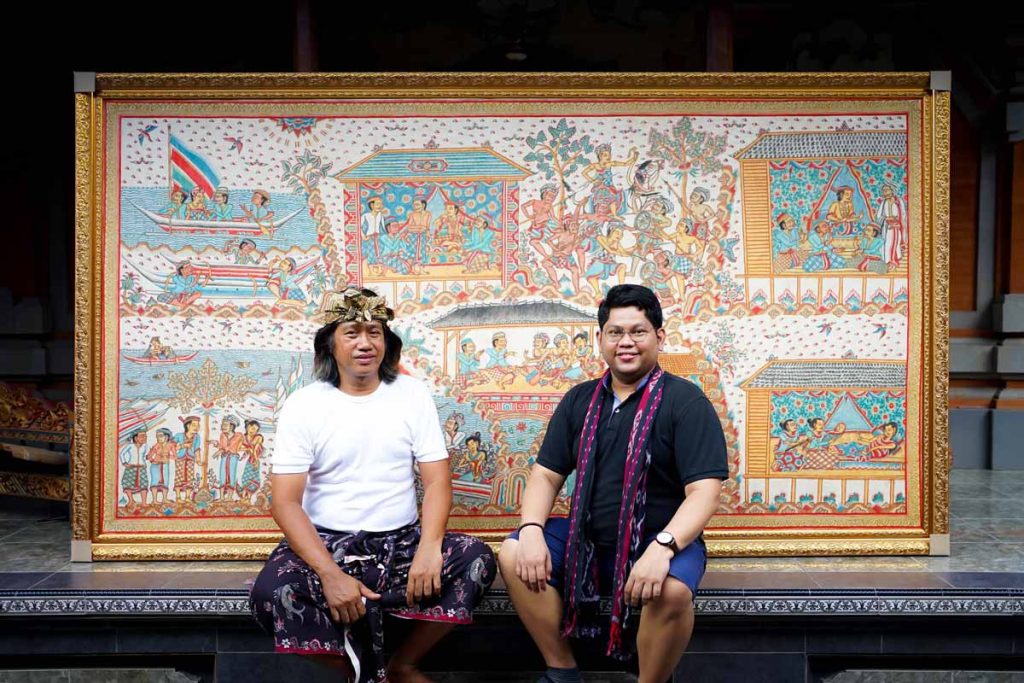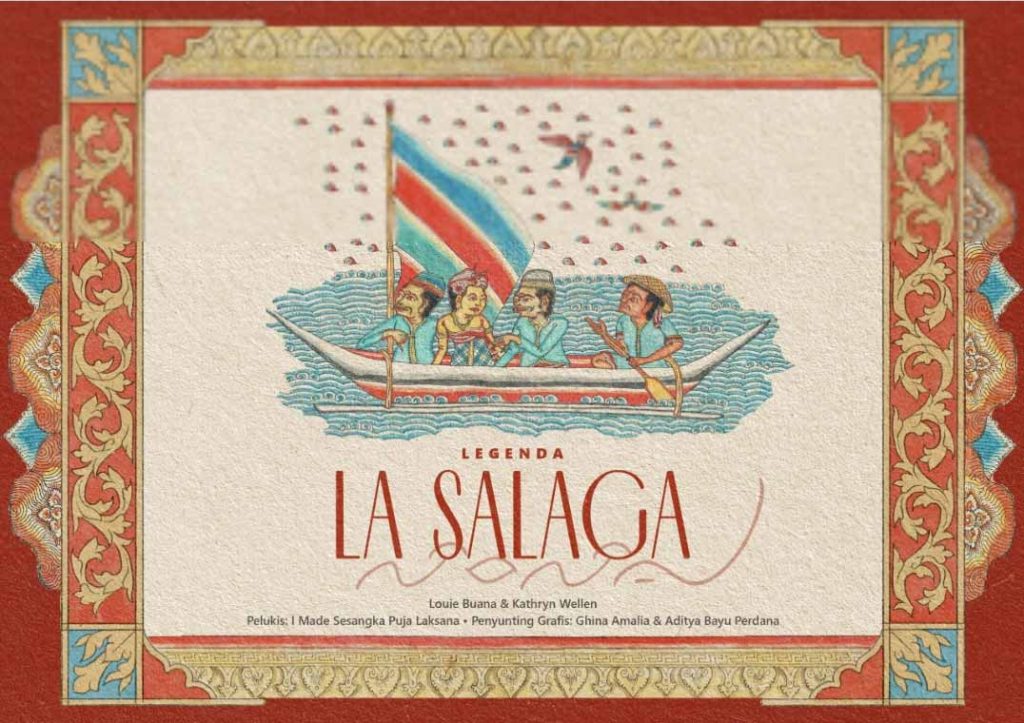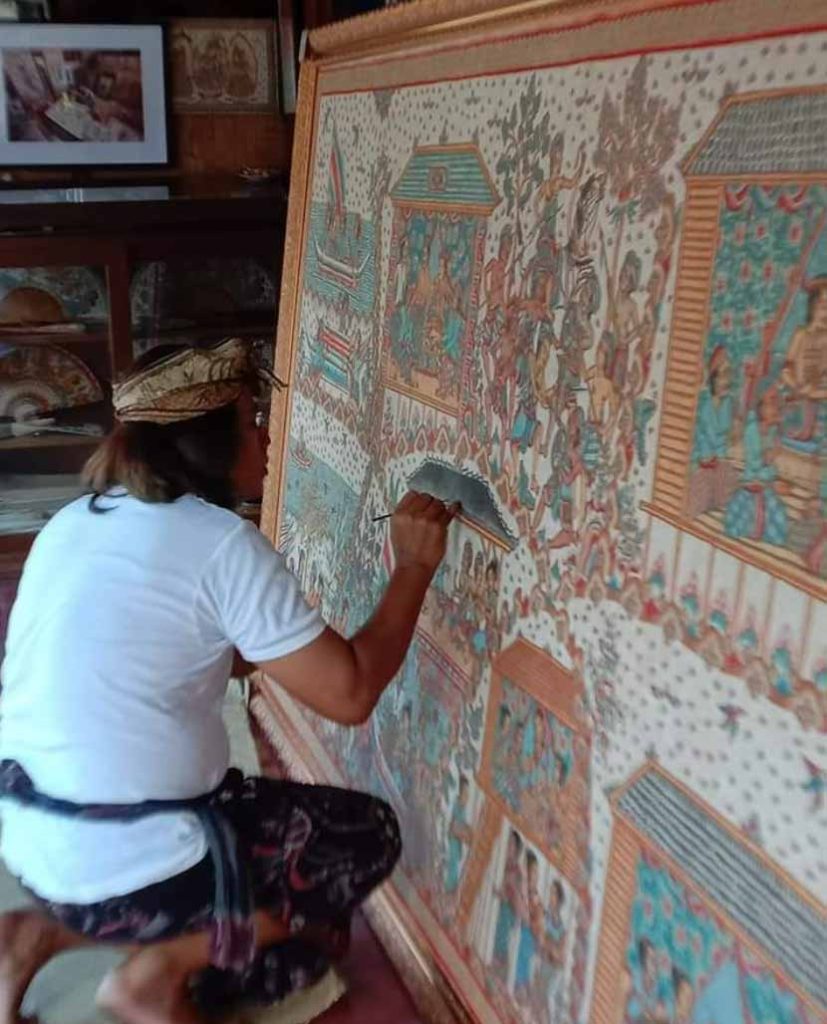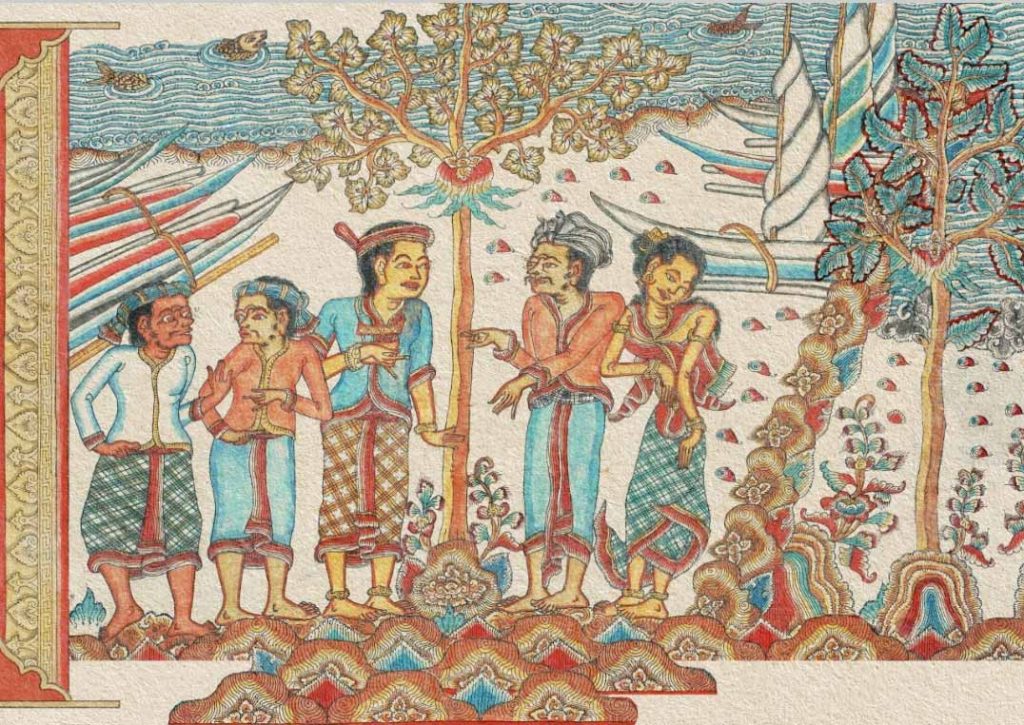The La Salaga legend from West Sulawesi is an epic that rivals the fantastic Hindu tales from the Mahabharata and the Ramayana. This distinct tale merging a new Islamic religious culture of Sulawesi with the Hindu’s of south Bali is, unfortunately, a lesser-known episode of Indonesian history within the local and national consciousness.

Made Sesangka & Louie Buana in front of the La Salaga painting. Image coutesy of Agit Primaswara
An exciting international collaboration seeks to transform this, connecting with new audiences across the generations. Presented at the Ubud Writers & Readers Festival (UWRF), 8-17 October 2021, the ‘La Salaga Project’ is a cooperative project between KITLV (Koninklijk Instituut voor Taal, or the Royal Netherlands Institute of Southeast Asian and Caribbean Studies) researcher Katherine Wellen, Indonesian cultural activist Louie Buana and the master Balinese traditional painter Made Sesangka.
“The project involves the commissioning and reinterpretation of the legend in the Classical Kamasan painting style. The picture will be used to illustrate a children’s book to bring this story to the younger age groups, their caregivers and teachers,” said Louie Buana. He partnered in March 2021 with Kathryn Wellen to initiate the project. Both share similar interests on topics related to South and West Sulawesi history and migration.
“The project will be supported by an online presentation and videos geared towards art historians, the public and tourists. Both Kathryn and I believe that this story is unique for showcasing the pre-colonial contact and multiculturalism between Sulawesi and Bali. Therefore, it deserves to be retold in new ways,” stated Louie, a law graduate of Universitas Gadjah Mada (Yogyakarta), with a degree in Colonial and Global History, Faculty of Humanities and European and International Human Rights Program, from Leiden University.
The ancient text from the Mandarese traditional manuscript (Lontar Mandar) describes family associations between Mamuju in West Sulawesi and Badung, Bali. The relationship is believed to have begun with the marriage between Puatta Mamuju and Mera’ara Puang and the birth of their son La Salaga. Raised in both Bali and Sulawesi, La Salaga grew to be a mighty warrior and battled against the Sasak people of Lombok and became a revered leader. Thus, the legend blends cultures from two regions of the archipelago. It is said to be one of the most extended narrative stories ever written.

‘La Salaga’ 2021 – by Balinese Kamasan master painter Made Sesangka Image Richard Horstman
“The KITLV launched ‘Atelier KITLV – Experimental Knowledge in Art, Activism, and Academia’ as a new space for cross-over experimentation between academics, artists, activists, writers, and journalists,” Kathryn shares. “Inspired by a longer-standing interest in exploring colonial structures of knowledge Atelier KITLV is seeking for ways and forms of decolonizing knowledge.”
The ‘La Salaga’ composition painted in the sacred Kamasan style is a narrative storyboard read from left to right and the bottom up. Nine individual scenarios are pieced together by Made Sesangka, creating his interpretation of the legend. The stylisation of characters has evolved from the famous wayang kulit shadow puppet theatre. The theatre is one of the oldest communication methods in the archipelago introduced by Indian traders who settled in commercial hubs over 2000 years ago.
What distinguishes the Kamasan characters is they are represented not on side profile like the puppets. Yet, the face is fully depicted to address others within the scene while also appearing to address the audience. The picture presented new challenges for Made, who pushed his creativity to new levels during the process.
“This has been an unusual and interesting project, unlike usual Kamasan paintings,” Made told me. “The challenge is to reach different traditions and diverse cultures, not only the Balinese. “The painting required my full concentration to successfully achieve the significant points of the narrative into each scenario and ten position them within the overall composition.”

Kamasan imagery printed in the La Salaga childrens book. Image courtesy of Agit Primaswara

Made-Sesangka-works-on-the-La-Salaga-painting.-Image-Made-Sesangka 
Kamasan images as printed in the La Salaga childrens book. Image courtesy of Agit Primaswara
Kamasan village, Klungkung, East Bali, is the historical epicentre for the development of sacred religious paintings. The style dates back to the first Bali kingdom established by the aristocracy of the East Javanese Majapahit Empire, the largest Indonesian political and economic power bases spread from Sumatra to Southern Thailand in the north and as far east as parts of the Philippines.
Positive feedback greeted the La Salaga Project during the UWRF, which presented a live online multi-country discussion. Asked by the audience whether ancient literature still has a place in the future, Kathryn replied: “I think that literature has a very enriching place in anyone’s life – anybody who wants to look for it will find beautiful things. So while it’s possible to ignore literary canons, they are very enriching, and they won’t stop enriching, even if the book remains closed, the beauty is still inside.”
“I see that there’s a cultural thirst among my generation to understand, to find, and to re-discover. I believe ancient literature still has a place not just today but in the future,” Louie stated. “It can be a source of inspiration for the new creative industry and personally in terms of spirituality. The journey to looking back and find ourselves.”
The La Salaga project moves forward. “We are in the process of printing the children’s book working with two talented Indonesians, illustrator Ghina Amalia and typographer Aditya Bayu Perdana. In addition, a ‘behind the scenes film about our project is being created by Agit Primaswara, to be uploaded to the Lontara Project Youtube account,” Louie explained.
“The book will be sent to various literacy communities, schools, and institutions all over Indonesia. Furthermore, the painting shall be displayed at Nusa Pustaka library in Polewali Mandar (West Sulawesi), where the King of Mamuju and a direct descendant of La Salaga, Maradika Mamuju, will be expecting me to receive the children’s book. Lastly, an academic article about the project will be written by Kathryn and myself.”
“The project’s value lies in its artistic reinterpretation of the legend; its mutual use of traditional and new media; its showcasing of the social interactions between different ethnicities and cultures in Indonesia; and its contribution to children’s literature,” Kathryn said.











